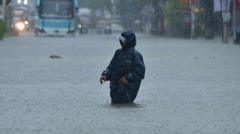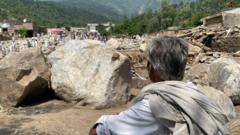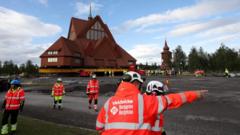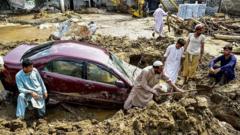With nearly 600 people rescued and schools closed, the city grapples with a climate crisis amid infrastructural inadequacies.
Mumbai's Monsoon Woes: Heavy Rain Causes Widespread Disruption

Mumbai's Monsoon Woes: Heavy Rain Causes Widespread Disruption
Historic downpours inundate India's financial hub, leading to chaos in transportation and evacuations.
Mumbai, India's bustling financial capital, has plunged into chaos due to relentless and heavy rainfall that has left many parts of the city underwater. With roads submerged and public transport in disarray, the consequences of this environmental barrage are felt in every corner of Mumbai, where waist-deep water has become a common sight. Authorities report that nearly 600 individuals were rescued after becoming trapped on an overcrowded monorail system that failed mid-route, leading to the need for medical treatment for some due to suffocation.
In response to the inundation, approximately 350 residents from low-lying areas have been evacuated to temporary shelters as schools and colleges remain closed. The India Meteorological Department has issued a red alert for Mumbai and adjoining districts, forecasting heavy rainfall to persist through Wednesday before the situation begins to improve later in the week. Despite the commonality of monsoon rains in Maharashtra during August, this year's deluge has been particularly severe, with over 800mm of rain recorded in just four days, surpassing normal levels for the month.
Tragic reports indicate that 21 individuals have lost their lives in rain-related incidents over the past four days. Mumbai's public transport system, especially its local trains vital for daily commuters, has come to a standstill, leaving thousands stranded as train services were severely disrupted. Operations at the international airport have also been affected, resulting in the cancellation of around 50 flights amid warnings of possible air traffic delays due to continued rain.
In light of the severe disruptions, opposition figures have criticized the government for inadequate emergency preparedness. Aaditya Thackeray, a member of the Shiv Sena (UBT) party, condemned the apparent lapse in governance, citing the lack of planning even with warnings of heavy rains in place. As citizens voice their frustrations about deteriorating infrastructure and repeated failures to address flooding issues, experts highlight the growing gap between infrastructural advancements and the urgent need for investments in drainage and climate-resilient facilities to accommodate Mumbai’s large and ever-increasing population.
In response to the inundation, approximately 350 residents from low-lying areas have been evacuated to temporary shelters as schools and colleges remain closed. The India Meteorological Department has issued a red alert for Mumbai and adjoining districts, forecasting heavy rainfall to persist through Wednesday before the situation begins to improve later in the week. Despite the commonality of monsoon rains in Maharashtra during August, this year's deluge has been particularly severe, with over 800mm of rain recorded in just four days, surpassing normal levels for the month.
Tragic reports indicate that 21 individuals have lost their lives in rain-related incidents over the past four days. Mumbai's public transport system, especially its local trains vital for daily commuters, has come to a standstill, leaving thousands stranded as train services were severely disrupted. Operations at the international airport have also been affected, resulting in the cancellation of around 50 flights amid warnings of possible air traffic delays due to continued rain.
In light of the severe disruptions, opposition figures have criticized the government for inadequate emergency preparedness. Aaditya Thackeray, a member of the Shiv Sena (UBT) party, condemned the apparent lapse in governance, citing the lack of planning even with warnings of heavy rains in place. As citizens voice their frustrations about deteriorating infrastructure and repeated failures to address flooding issues, experts highlight the growing gap between infrastructural advancements and the urgent need for investments in drainage and climate-resilient facilities to accommodate Mumbai’s large and ever-increasing population.


















